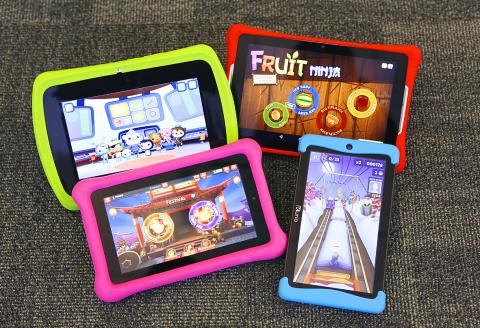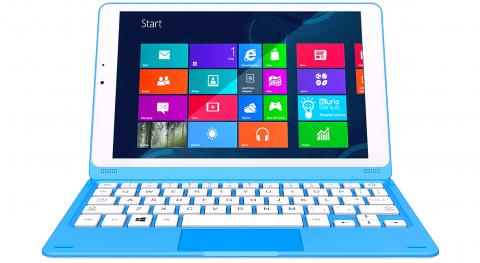Kiddie tablets have grown up.
Tablets designed just for kids are getting more sophisticated as they face increased competition from regular tablets. The new products also have better screens, speedier chips and fashionably slim bodies. They let older children do more, yet hold their hands until they are ready for unsupervised access.
Although many of the tablets were originally conceived as educational toys for kids as old as middle schoolers, they have been more popular with younger children. Older kids have been apt to reject them in favor of their parents’ tablet or smartphone.

Photo: AP
That shift has prompted companies to focus more on preschoolers and kindergarteners, as they create super-durable products that can withstand repeated abuse, and develop games and apps that teach reading and math.
However, some of those firms are now looking to take back some of the sales to older kids that they have lost over the years, offering premium products — most with price tags of more than US$100 — that look and perform less like toys and more like the ones adults use.
LeapFrog, maker of the toy-like LeapPad, released its first Android tablet this year, and Kurio is branching out to Windows 10 and includes a full version of Microsoft Office in a new tablet-laptop combination.

Photo: AP
The use of Android and Windows software, in place of the more basic, custom-made systems used in toy tablets, allows for more sophisticated apps and games, and a range of content from standard app stores.
LeapFrog vice president for product marketing Monica Brown said the company aimed to “create something that was kind of sleek and more tech forward for kids who were looking for something that felt like their parents’ tablet.”
However, parents still want educational content and safety features that come with a tablet designed purely for kids. LeapFrog’s Epic, along with the other new tablets for kids, are attempts to bridge that gap.
The Epic looks like a regular Android tablet, but comes with a removable bright-green bumper. It is much faster than a LeapPad and can run versions of popular Android games such as Fruit Ninja and Doodle Jump.
There is access to the Internet, but it is limited to about 10,000 kid-safe Web sites (though parents can add others). Parents can also limit and track how much time a child spends watching videos, playing games or reading.
Lynn Schofield Clark, a professor of media studies at the University of Denver, said kids’ tablets are a tough sell these days.
“Kids are always aspirational in their ages, and they’re always interested in what older kids are doing,” Clark said, pointing to the fascination that many preteens have with smartphones as a prime example.
Meanwhile, most parents will not spend money on kids-only gadgets unless they believe they offer significant educational benefits.
“If they’re just looking for something to entertain their kid, then why wouldn’t they just hand over their smartphone?” she asked.
Kurio aims to answer that question with the Smart, a device that let kids do things they previously might have needed their parents’ laptop for, such as typing and saving their homework online or playing video on their TV through an HDMI cable. The Smart is a Windows 10 laptop with a detachable screen and comes with a free year of Microsoft Office.
Kurio strategic director Eric Levin said kids using children’s tablets are getting younger, as older kids gravitate toward adult products.
Four years ago, he said, most Kurio users ranged from ages 6 to 12. Now, half of them are 3 to 5.
Although older kids may be ready for adult tablets, the shift has left those 8 to 12 without age-appropriate devices, Levin said. The Smart tries to fix that.
Other makers of kids’ tablets have also gone high-end this year. Fuhu bills the Nabi Elev-8 as a premium, 8-inch tablet. However, the company ran into financial problems early in the holiday season, and its products have been tough to find.
Nonetheless, adult tablets remain popular with kids.
Amazon touts its Fire tablet as something the entire family can use, eliminating the need to buy something just for the kids.
“While I appreciate that might have led other companies to adjust their products, we’re upping our game based on what customers want in the best kid experience,” said Aaron Bromberg, senior manager of product management for Amazon Devices.
The tablet’s FreeTime app lets parents set up profiles for each kid, with access to only the content they approve. It also lets parents limit the amount of time spent on different kinds of content such as videos or apps.
For an additional fee, Amazon’s FreeTime Unlimited service offers more than 10,000 books, apps, games and videos geared toward kids ages 3 to 10.
Nonetheless, Amazon is selling a kids’ edition tablet for US$100. It is essentially Amazon’s bare-bones US$50 Fire tablet packaged with a colorful protective bumper and a year’s subscription to FreeTime Unlimited.
It also comes with a two-year guarantee: If your kid breaks it, Amazon will replace it.

Intel Corp chief executive officer Lip-Bu Tan (陳立武) is expected to meet with Taiwanese suppliers next month in conjunction with the opening of the Computex Taipei trade show, supply chain sources said on Monday. The visit, the first for Tan to Taiwan since assuming his new post last month, would be aimed at enhancing Intel’s ties with suppliers in Taiwan as he attempts to help turn around the struggling US chipmaker, the sources said. Tan is to hold a banquet to celebrate Intel’s 40-year presence in Taiwan before Computex opens on May 20 and invite dozens of Taiwanese suppliers to exchange views

Application-specific integrated circuit designer Faraday Technology Corp (智原) yesterday said that although revenue this quarter would decline 30 percent from last quarter, it retained its full-year forecast of revenue growth of 100 percent. The company attributed the quarterly drop to a slowdown in customers’ production of chips using Faraday’s advanced packaging technology. The company is still confident about its revenue growth this year, given its strong “design-win” — or the projects it won to help customers design their chips, Faraday president Steve Wang (王國雍) told an online earnings conference. “The design-win this year is better than we expected. We believe we will win

Chizuko Kimura has become the first female sushi chef in the world to win a Michelin star, fulfilling a promise she made to her dying husband to continue his legacy. The 54-year-old Japanese chef regained the Michelin star her late husband, Shunei Kimura, won three years ago for their Sushi Shunei restaurant in Paris. For Shunei Kimura, the star was a dream come true. However, the joy was short-lived. He died from cancer just three months later in June 2022. He was 65. The following year, the restaurant in the heart of Montmartre lost its star rating. Chizuko Kimura insisted that the new star is still down

While China’s leaders use their economic and political might to fight US President Donald Trump’s trade war “to the end,” its army of social media soldiers are embarking on a more humorous campaign online. Trump’s tariff blitz has seen Washington and Beijing impose eye-watering duties on imports from the other, fanning a standoff between the economic superpowers that has sparked global recession fears and sent markets into a tailspin. Trump says his policy is a response to years of being “ripped off” by other countries and aims to bring manufacturing to the US, forcing companies to employ US workers. However, China’s online warriors